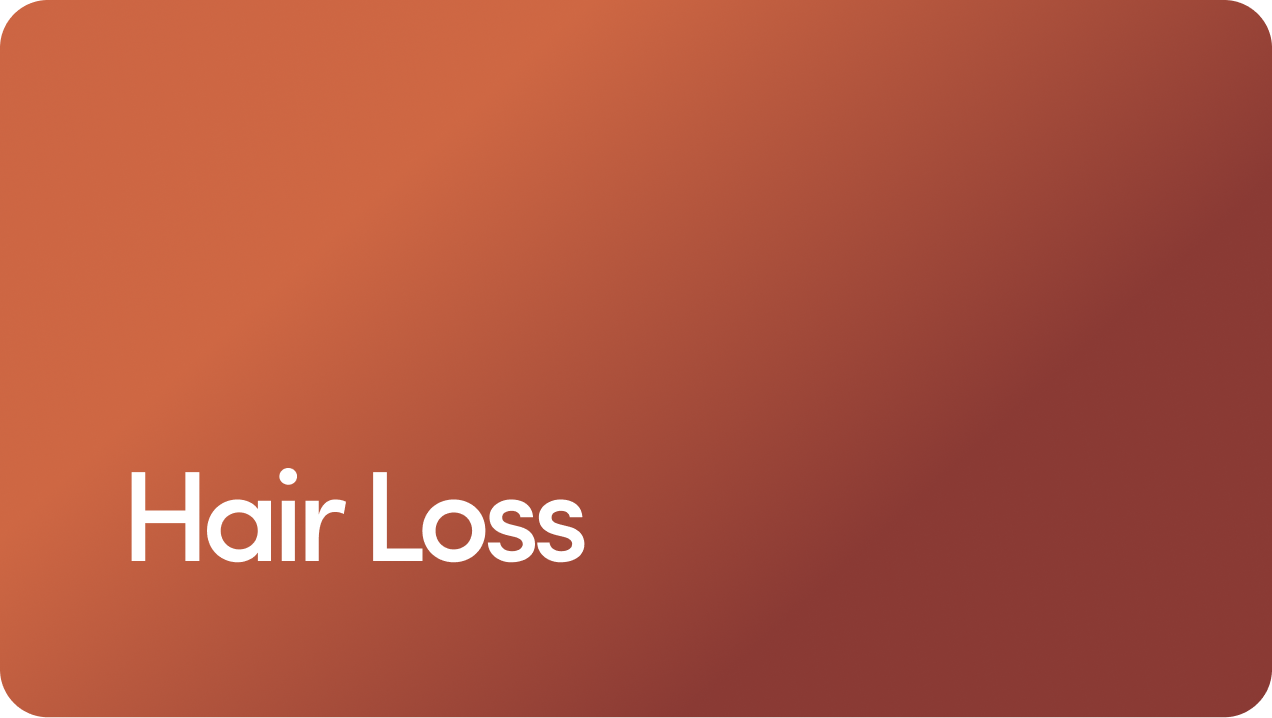How to Get Healthy Hair: A Guide for Men
Most guys don’t think much about how to get healthy hair until they start noticing issues like excessive shedding, breakage, or hair loss.
Overview
Most guys don’t think much about how to get healthy hair until they start noticing issues like excessive shedding, breakage, or hair loss. The good news? You don’t need a 12-step routine or expensive salon treatments to get healthier, stronger hair.
Healthy hair starts with three things:
Proper care
The right nutrients
Good scalp hygiene
Whether your goal is to grow thicker hair, prevent damage, or just make sure your hair looks its best, small adjustments to your hair care routine can make a big difference.
How to Get Healthy Hair: 10 Tips for Men
Here are our top tips for healthy hair — including advice on washing your hair, styling, and practicing good scalp care:
Wash your hair the right way
Condition every time you wash
Keep your scalp healthy
Eat nutrient-dense foods for stronger hair
Be gentle with your hair
Get regular trims
Use the right styling products
Stay hydrated
Consider supplements
Seek professional help if needed
When practiced regularly, these habits for how to improve hair health will serve your hair and scalp for years to come!
1. Wash Your Hair the Right Way
For most hair types, two to three washes a week is the sweet spot. Oily hair might need to be washed more often, while dry hair might benefit from fewer washes.
Most men either wash their hair too much or not enough. Washing too often can strip your scalp of natural oils, leading to dry, brittle hair. Not washing enough can cause oil buildup, clogged hair follicles, and even dandruff.
For healthier hair, keep these shampooing tips in mind:
Use a gentle, sulfate-free shampoo. Formulas without sulfates will cleanse your hair without stripping moisture. They can also help preserve your hair color if you dye your hair.
Massage shampoo into your scalp. To remove excess oil and buildup, focus on lathering the shampoo on your scalp, not just the ends of your hair.
Rinse with lukewarm or cool water. Hot water can weaken hair and dry out your scalp.
Consider a clarifying shampoo. If you struggle with oil or product buildup, you might benefit from using a clarifying shampoo once a week (or less often).
If you work out often and sweat a lot, rinsing your hair with water between washes can help keep it fresh without over-shampooing.
Our guide has more insight into how often to wash your hair.
2. Condition Every Time You Wash
If you think conditioner is just for long hair, think again. The American Academy of Dermatology recommends conditioning after every shampoo to keep hair hydrated, soft, and easier to manage. Plus, it reduces dryness, breakage, and split ends.
Here’s how to use conditioner for optimal results:
Apply conditioner from the mid-lengths down to the ends of your hair, not the scalp or roots.
Leave it on for one to two minutes.
Rinse thoroughly with cool or lukewarm water.
If you have dry hair, try a leave-in conditioner or deep-conditioning hair mask for extra moisture and elasticity.
3. Keep Your Scalp Healthy
A healthy scalp equals healthy hair. Certain scalp conditions affect hair growth, leading to issues like hair thinning or breakage.
Here are some tips for scalp care:
Give yourself a scalp massage while shampooing to boost blood circulation and promote growth.
Use a scalp scrub or exfoliating shampoo once a week to remove buildup.
If you have dandruff, look for a treatment like our dandruff detox shampoo, which contains 1% pyrithione zinc and salicylic acid.
Try natural oils like coconut, jojoba, or argan oil for extra hydration.
Contact a healthcare professional if you have — or think you have — a scalp infection. The symptoms of scalp infections include itching, redness, and a burning sensation. A healthcare provider might prescribe a treatment or recommend something you can buy over the counter.
4. Eat Nutrient-Dense Foods for Stronger Hair
Your hair is made of protein, so what you eat affects its strength and growth. If your diet is lacking in key nutrients, your hair might become weaker, thinner, or shed more than usual.
Try to eat a healthy, balanced diet, including:
Eggs
Fatty fish (salmon, mackerel, sardines)
Avocados, olive oil, and other healthy fats
Vegetables and fruits
Nuts and seeds
Beans and lentils
Chicken and other lean meats
If you’re experiencing hair thinning or hair loss, check with a medical provider about possible nutrient deficiencies (especially iron, biotin, and vitamin D).
5. Be Gentle With Your Hair
Hair isn’t indestructible. If you pull, tug, or style it aggressively, you could damage the hair shaft, possibly leading to breakage.
The American Academy of Dermatology recommends avoiding:
Brushing wet hair aggressively. Wet hair is weaker and more prone to breakage than dry hair. Use a wide-tooth comb instead.
Tugging on tangles. Instead, gently detangle your hair using a deep conditioning treatment to prevent breakage.
Tight hairstyles. Super-tight styles like man-buns, ponytails, or braids can pull on your scalp and hair follicles. This sometimes leads to a form of hair loss called traction alopecia.
Using too much heat. If you use heat-styling tools, turn the temperature setting down and always use a heat-protectant spray or serum to prevent damage.
Aggressively towel-drying your hair. Wrap your hair in a towel to absorb water, air-dry your hair, or use a hair dryer on the lowest heat setting.
Harsh chemical treatments. Frequent chemical treatments — for example, bleaching, perming, or relaxing hair — can damage the hair cuticle.
On the topic of handling hair gently, consider using a satin or silk pillowcase. It reduces friction on the hair shaft, which might help prevent breakage, frizz, and split ends.
6. Trim Regularly to Prevent Split Ends
Contrary to popular belief, regular trims don’t make your hair grow faster. But they do prevent split ends, keeping your hair looking healthy.
In general, you’ll want to trim your hair once every six to 12 weeks. Consult a barber or stylist if you’re not sure how often you should cut your hair. If you notice lots of split ends, dryness, or rough texture, it’s probably time for a haircut.
7. Use the Right Styling Products
Some hair care products nourish and protect hair, while others cause buildup, dryness, or irritation.
Avoid alcohol-based hair gels, which can dry out your hair and scalp. Also, although using dry shampoo once in a while is okay, remember that it doesn’t actually clean your scalp — so be sure to give your hair an actual wash to prevent buildup.
Consider opting for:
Lightweight styling creams or pastes. These provide hold without buildup.
Water-based gels. These are less drying than alcohol-based formulas.
Leave-in conditioners. They hydrate and protect hair from damage.
Heat protectants. If you blow-dry or straighten your hair, heat protectants can help prevent hair damage while adding shine.
Always look for styling products that suit your hair texture and type. A hair care product that works well on dry, thick, or curly hair might not work for someone with fine, straight hair.
8. Stay Hydrated
Here’s yet another reason to keep gulping down water. Dehydration doesn’t just affect your skin, organs, and mood — it can also make your hair dry, brittle, and prone to breakage.
There’s no consensus on exactly how much water to drink per day, but it’s usually best to aim for at least eight glasses (64 ounces). You may need more water if you sweat a lot or exercise frequently.
9. Consider Supplements
If your diet lacks key nutrients, vitamins or supplements may help support better hair health.
Hair supplements often contain these nutrients:
If you’d like to try a hair growth supplement, consider our biotin gummies.
Having said that, supplements generally only help if you have a nutrient deficiency. If you’re experiencing significant hair loss, talk to a healthcare professional before starting a new dietary supplement.
10. Know When to Call in the Experts
If you’re noticing thinning hair, excessive shedding, or changes in your scalp health, it might be time to seek professional guidance.
While adjusting your hair care routine can help improve hair health, persistent hair loss is often a sign of an underlying issue — one that a healthcare provider can help diagnose and treat.
It’s a good idea to speak with an expert if you’re dealing with:
Hair thinning or increased hair fall
An irritated, sore, or inflamed scalp
Persistent dandruff
Hair loss is often progressive, meaning the sooner you seek treatment, the better your chances of maintaining a full, healthy head of hair.
Instead of guessing what’s causing your hair concerns, turn to a healthcare professional. They can assess your symptoms and recommend science-backed treatments that actually work.
Final Thoughts: How to Keep Hair Healthy
Getting healthy, great-looking hair isn’t about using the most expensive products — it’s about building a healthy hair routine.
Here’s how to get healthy hair in a nutshell:
Wash your hair two to three times a week with gentle shampoo. This will help keep your scalp clean, hydrated, and free of buildup.
Eat a healthy, balanced diet full of nutrients that support hair growth. Also, don’t forget to drink plenty of water.
Be gentle when styling to avoid unnecessary damage. Don’t wear super-tight hairstyles, and apply a heat-protectant product whenever you use a hair dryer or other hot tools.
Lastly, if you experience issues like hair thinning or persistent dandruff, consider speaking with a healthcare provider. They can help you get the treatment you need.
By taking care of your scalp, hair, and overall health, you can keep your hair strong, thick, and looking its best — without overcomplicating things.
If you’re facing hair loss, you can take our free online assessment to start exploring your treatment options.
7 Sources
- Al Aboud AM, et al. (2024). Alopecia. https://www.ncbi.nlm.nih.gov/books/NBK538178/
- Almohanna HM, et al. (2019). The role of vitamins and minerals in hair loss: a review. https://www.ncbi.nlm.nih.gov/pmc/articles/PMC6380979/
- American Academy of Dermatology Association (AAD). (n.d.). 10 hair care habits that can damage your hair. https://www.aad.org/public/everyday-care/hair-scalp-care/hair/habits-that-damage-hair
- American Academy of Dermatology Association (AAD). (n.d.). Tips for healthy hair. https://www.aad.org/public/everyday-care/hair-scalp-care/hair/healthy-hair-tips
- Guo EL, et al. (2017). Diet and hair loss: effects of nutrient deficiency and supplement use. https://www.ncbi.nlm.nih.gov/pmc/articles/PMC5315033/
- Trüeb RM, et al. (2018). Scalp condition impacts hair growth and retention via oxidative stress. https://www.ncbi.nlm.nih.gov/pmc/articles/PMC6369642/
- Tucker D. (2024). Seborrheic dermatitis. https://www.ncbi.nlm.nih.gov/books/NBK551707/
Editorial Standards
Hims & Hers has strict sourcing guidelines to ensure our content is accurate and current. We rely on peer-reviewed studies, academic research institutions, and medical associations. We strive to use primary sources and refrain from using tertiary references. See a mistake? Let us know at [email protected]!
Related Conditions
 Hair Loss
Hair Loss
 Male Pattern Baldness
Male Pattern Baldness
 Dandruff
Dandruff
 Scarring Alopecia
Scarring Alopecia
 Seborrheic Dermatitis
Seborrheic Dermatitis
*All images feature a model portrayal
(unless otherwise noted).
